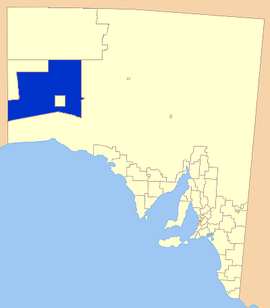Maralinga Tjarutja
|
Maralinga Tjarutja South Australia |
|||||||||||||
|---|---|---|---|---|---|---|---|---|---|---|---|---|---|

Location of the Maralinga Tjarutja Council
|
|||||||||||||
| Population | 105 (2006) | ||||||||||||
| • Density | 0.001/km2 (0.0026/sq mi) | ||||||||||||
| Established | 2006 | ||||||||||||
| Area | 102,863.6 km2 (39,715.9 sq mi) | ||||||||||||
| Council seat | Ceduna (outside Council area) | ||||||||||||
| Region | Eyre Western | ||||||||||||
| State electorate(s) | Flinders | ||||||||||||
| Federal Division(s) | Grey | ||||||||||||
| Website | Maralinga Tjarutja | ||||||||||||
|
|||||||||||||
The Maralinga Tjarutja is the corporation representing the traditional Anangu owners of the remote western areas of South Australia known as the Maralinga Tjarutja lands. It is one of the four regions local government areas of South Australia classified an Aboriginal Council (AC) and not incorporated within a local government area. This indigenous Australian people whose historic rights over the area have been officially recognized belong to the southern branch of the Pitjantjatjara people. They have a community centre at Oak Valley, 520 miles NW of Ceduna, and close historicasl and kinship links with the Yalata 350km south, and the Pila Nguru centre of Tjuntjuntjara 370km to their west.
The Maralinga Tjarutja people belong to a general Western Desert ecological zone sharing cultural affinities with the Pitjantjatjara, Yankunytjatjara and Ngaanyatjarra to their north and the Pila Nguru of the spinifex plains to their west, They speak dialects of Pitjantjatjara and Yankunytjatjara.
The term maralinga is not of local origin. It is a term chosen from the Garig or Garik dialect of the now-extinct Northern Territory Ilgar language, signifying 'field of thunder/thunder', and was selected to designate the area where atomic bomb testing was to be undertaken by the then Chief Scientist of the Department of Supply, W. A. S. Butement. The land was covered in spinifex grasses and good red soil (parna wiru) furnishing fine camping.
...
Wikipedia
